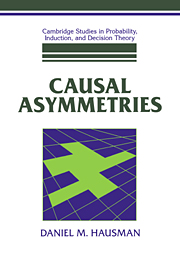Book contents
- Frontmatter
- Contents
- List of Figures
- Acknowledgments
- Introduction: Causation and its Asymmetries
- 1 Metaphysical Pictures and Wishes
- 1* Transfer Theories
- 2 Is Causation a Relation Among Events?
- 3 Causation, Regularities, and Time: Hume's Theory
- 4 Causation and Independence
- 4* Causation, Independence, and Causal Connection
- 5 Agency Theory
- 5* Causal Generalizations and Agency
- 6 The Counterfactual Theory
- 6* Independence and Counterfactual Dependence
- 7 Counterfactuals, Agency, and Independence
- 7* Agency, Counterfactuals, and Independence
- 8 Causation, Explanation, and Laws
- 8* Causation, Explanation, and Independent Alterability
- 9 Probabilistic Causation
- 10 Causation and Conditional Probabilities
- 10* Causal Graphs and Conditional Probabilistic Dependencies
- 11 Intervention, Robustness, and Probabilistic Dependence
- 11* Interventions and Conditional Probabilities
- 12 Operationalizing and Revising the Independence Theory
- 12* Probability Distributions and Causation
- 13 Complications and Conclusions
- Appendix A Alphabetical List of Propositions
- Appendix B List of Theorems
- References
- Index
10* - Causal Graphs and Conditional Probabilistic Dependencies
Published online by Cambridge University Press: 20 April 2010
- Frontmatter
- Contents
- List of Figures
- Acknowledgments
- Introduction: Causation and its Asymmetries
- 1 Metaphysical Pictures and Wishes
- 1* Transfer Theories
- 2 Is Causation a Relation Among Events?
- 3 Causation, Regularities, and Time: Hume's Theory
- 4 Causation and Independence
- 4* Causation, Independence, and Causal Connection
- 5 Agency Theory
- 5* Causal Generalizations and Agency
- 6 The Counterfactual Theory
- 6* Independence and Counterfactual Dependence
- 7 Counterfactuals, Agency, and Independence
- 7* Agency, Counterfactuals, and Independence
- 8 Causation, Explanation, and Laws
- 8* Causation, Explanation, and Independent Alterability
- 9 Probabilistic Causation
- 10 Causation and Conditional Probabilities
- 10* Causal Graphs and Conditional Probabilistic Dependencies
- 11 Intervention, Robustness, and Probabilistic Dependence
- 11* Interventions and Conditional Probabilities
- 12 Operationalizing and Revising the Independence Theory
- 12* Probability Distributions and Causation
- 13 Complications and Conclusions
- Appendix A Alphabetical List of Propositions
- Appendix B List of Theorems
- References
- Index
Summary
Independence Implies Screening-Off
If causes are INUS conditions, the following two theorems (which are sketched by Papineau (1985b, p. 63 and 1985a, p. 279)) establish that effects are probabilistically dependent on their causes and that common causes screen off their effects.
Theorem 10.1: If is probabilistically independent of S and Z, and
Theorem 10.2: If (3) C is probabilistically independent of S, Z, Y, and W, (4) S, Z, Y, and W are probabilistically independent of one another, and (5) all probabilities are intermediate, then C and ∈C screen off A and B.
Proof: Given premises 1–3 and 5, Given premise which by 1, 2, 3, and 5 equals. Since Z and W are independent, and.
In Papineau's view, screening-off is explained by the independence among different deterministic causal facts.
Causal Graphs and Probability Distributions – Some Formal Results
In this section I shall sketch the proof of the striking theorem discussed in §10.3.
Theorem 10.3 CM and F imply
(Direct causal connection) For all x andy in V, x and y are adjacent if and only if they are probabilistically dependent conditional on every subset of <I>V that does not include them, and
(Direct causation) For all x, y and z in V, if JC and y and y and z are adjacent, and JC and z are not adjacent, then V causally depends on x and z if and only if x and z are probabilistically dependent conditional on every subset of Fthat contains y but not y or z.
- Type
- Chapter
- Information
- Causal Asymmetries , pp. 217 - 221Publisher: Cambridge University PressPrint publication year: 1998



